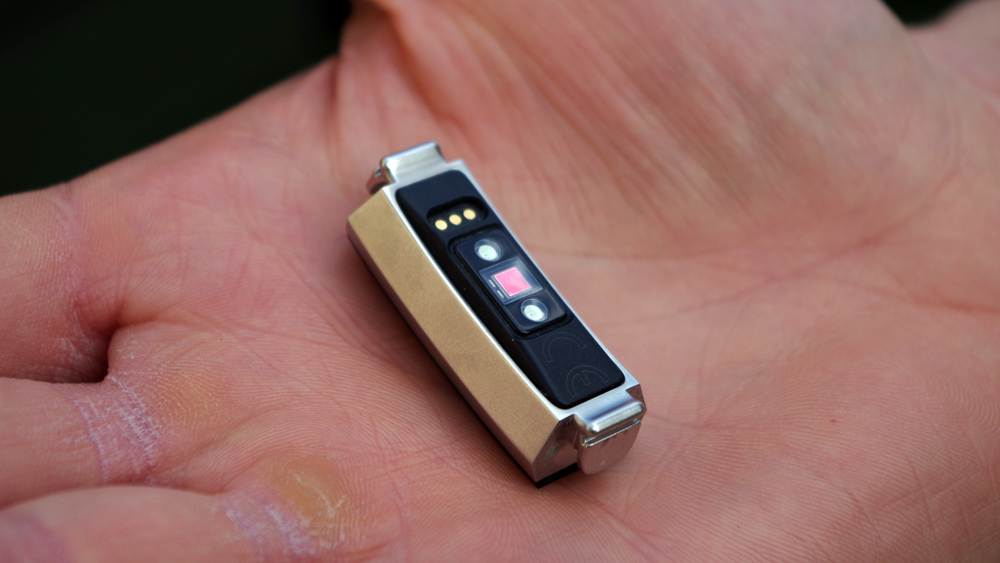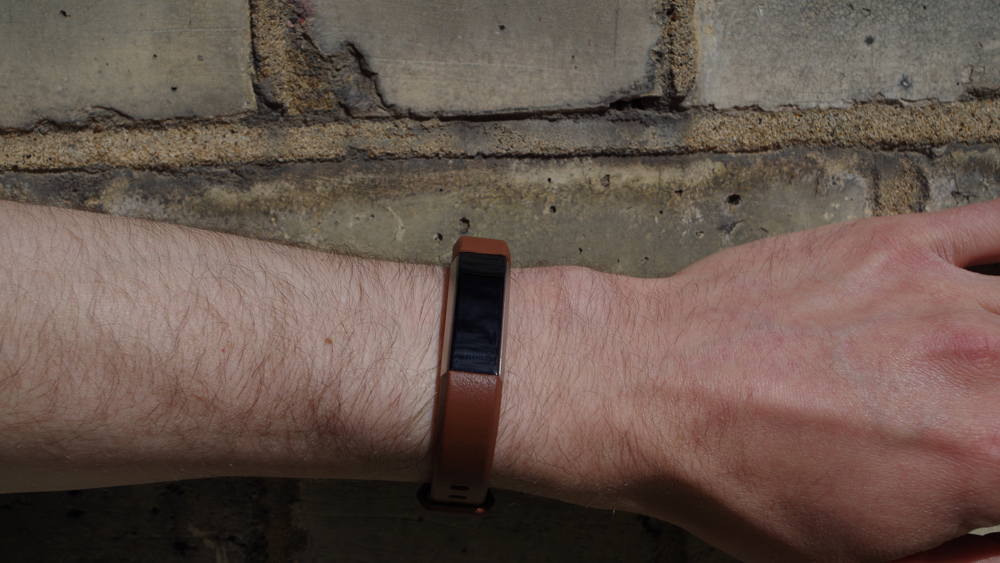Our Verdict
Adding a heart rate monitor brings all manner of benefits for just £30 more (than the standard Alta). SmartTrack automatic exercise recognition never puts a step wrong and saved us from forgetting to press stop at the end of a session (happens a lot). While there’s no advertised assisted GPS as on Fitbit’s Charge 2, there is a workaround using the Fitbit app that does pretty much the same thing. Apart from the Apple Watch 2, you won’t find another feature-packed tracker that looks so good. While this is true across all Fitbit models with a heart rate monitor, the Cardio Fitness score and sleep tracking provide essential context to help you understand your numbers. Finally. It’s so close in price to the Charge 2 we can’t help but feel it’s worth paying that bit more, even if the Charge 2 is less svelte. SmartTrack is great, but apart from your heart rate there’s no mid-exercise info displayed on the tracker’s screen, which is especially frustrating when running. The screen can be hard to read in daylight and there’s an art to getting the screen to activate.
You can trust Coach
Fitbit Alta HR In-Depth
Using The Fitbit Alta HR As A Heart Rate Monitor
The original Alta now costs £100 (although it can be found for even less online), so is it worth spending an extra £30 for an optical heart rate monitor? Yes it absolutely is.

The addition of heart rate monitoring means greater accuracy in tracking the calories you burn and results in a more detailed breakdown of sleep (more on that later). The Alta HR can now also give an estimate of your resting heart rate, an excellent indicator of general fitness.
RECOMMENDED: What Is A Healthy Resting Heart Rate And Why Does It Matter?
A few months after launching, Fitbit upgraded the app to offer Alta HR users Cardio Fitness Score, a feature that had previously only been available on the Charge 2 and Blaze. It’s an estimate of VO₂ max, or how efficiently your body can use oxygen, based on your resting heart rate and other bits from profile including your weight. While this could have been just another number, Fitbit cleverly places you on a spectrum of people of the same sex and age range.
Subsequent screens in the app then suggest how much you could improve the score with exercise, especially HIIT, or if you drop 5lb (2.3kg) of weight. If there’s one complaint we have with fitness trackers it’s that numbers are often provided without any context, so we give Fitbit a big hand for adding this feature and explaining it.
After exercising you’ll find a breakdown of your session in the app, which will give you a line graph of your heart rate for the duration and a breakdown of time spent in certain zones: fat burn (essentially light exercise), cardio (moderate exercise) and peak.Reviewing the times spent in certain zones is especially useful if you take a HIIT class where, if properly structured, you should be hitting the peak zone regularly, if briefly. It acted as a timely reminder to us, at least, that we should put more effort in.
One question with all wrist-based heart rate monitors is accuracy and the ability to respond quickly to rapid changes in heart rate. We haven’t tested the Alta HR against a chest strap (which are inevitably more accurate), but we found it mostly passed the “that’s reasonable” test. Our resting heart rate moved around appropriately according to how active we were and there were no outlandish readings when we looked at the screen during exercise.
Occasionally, however, we did find it didn’t display a heart rate during exercise even though we were wearing it according to Fitbit’s guidelines for exercise (tight and two finger-widths above the wrist bone). This was pretty rare, though.
RECOMMENDED: The Best Heart Rate Monitors
Using The Fitbit Alta HR For Step Counting
The 10,000 steps goal took a bit of kicking earlier this year, although Fitbit can happily point to its 2017 focus on heart rate and sleep to avoid some of the heat. The step goal is still front and centre when you open the Fitbit app, but we’re fine with that – 10,000 steps is a perfectly legitimate marker and don’t let anyone tell you otherwise.
There’s also the option in the app to change the step target up or down, depending on your starting point and progress.
We found ourselves hitting the 10,000-step goal a little earlier in the day than usual (we are very much creatures of habit) so the Alta HR may be a bit more sensitive to movement, but not outrageously so, and we have no way of knowing if our previous tracker was more or less accurate.
With all things tracker-related, it’s not really the absolute number that counts, it’s how it changes over time. Fitbit seems to know that and offers breakdowns of your steps over a day, a week, a month, three months or a year.
One feature that can be found in other models in this price bracket, but isn’t present on the Alta HR, is an altimeter to count stairs climbed. In the Fitbit range, that’s present in the Charge 2 and above, but Fitbit can be forgiven the omission on the Alta HR. They’ve already managed to fit a heart rate monitor into the Alta’s svelte frame.
Using The Fitbit Alta HR For Running
The Alta HR automatically recognises and categorises 15 minutes or more of running as an exercise event (although you can reduce this time limit in the settings). Afterwards it provides you with the time spent running, a graph of your heart rate and the time spent in the three heart rate zones, calories burned and steps taken.
Strangely, Fitbit doesn’t take a stab at estimating the distance you ran (something Garmin’s Vivosmart 3 does a decent job of), although it will give you the distance travelled in the day.
But, if you’re happy to run with your phone, you’re able to track distance (and therefore pace) using your phone’s GPS. Once you’re done and check your exercise log, you’ll see the app’s married the GPS data with the heart rate SmartTrack noted.
Considering assisted GPS is one of the main differences between the Alta HR and the Charge 2, it’s surprising Fitbit left this workaround in.
Where the Alta HR does fall down, however, is that it can’t see any of the GPS info (time, distance or pace data) on your wrist as you run. In fact, because SmartTrack isn’t shown on the screen at all you can’t even see a timer of how long you’ve been running for. You can keep tabs on your heart rate, which is useful if you’re following a training plan and like to use heart rate zones instead of terms like easy, steady and tempo, or if you’re looking to run intervals. But if you are that into your running that you’re planning on intervals, we’d recommend the Charge 2 – which has a feature dedicated to just that.
RECOMMENDED: The Best Running Watches
Using The Fitbit Alta HR For Cycling
Although there’s no cycling option when starting GPS tracking in the app, it’ll still match itself up to a SmartTrack cycling event. Otherwise the Alta HR tracks exactly the same things for cycling as it does for running. It works if you’re a casual cyclist – perhaps a commuter like us – and want the activity to count towards your goals, but if you’re at all into cycling the Alta HR will feel feature-light pretty quickly.
Using The Fitbit Alta HR For Swimming
The Alta HR isn’t waterproof so don’t take it into the pool or the shower. Fitbit only offers swim tracking on the cheaper Flex 2 – it seems to be one area that Fitbit’s happy to leave to the competition for now.
RECOMMENDED: The Best Waterproof Fitness Trackers
Using The Fitbit Alta HR For Calorie Counting
The addition of heart rate data should make the estimates of calories burned more accurate, although we can’t test whether that’s true or not. It’s useful that Fitbit tracks total calorie count, including those burned at rest, which is essential if you’re counting calories to lose weight.
The Fitbit app sets a calories burned target based on your profile info, although you can edit this. If you log food in the Fitbit app, it’ll also give you a dynamic calorie count as well as a breakdown of macronutrients (carbs, fat and protein).
If you eat a lot of processed food this could be very useful because there’s a barcode scanner that’ll bring in all the info. It’s less useful if, like us, you cook wholefoods and have little idea of the weight of food you’re eating. You could spend a week diligently measuring and recording the regular items you make, but we couldn’t bring ourselves to perform such a soul-sucking task.
Using The Fitbit Alta HR As A Sleep Tracker
The Alta HR is the cheapest wearable in Fitbit’s line-up that offers Sleep Stages, which uses the heart rate monitor to add REM tracking to the breakdown of awake, light and deep sleep that’s common across brands.
Big whoop, you may say, but drill down into a night’s tracking and Fitbit will explain what each stage means and, crucially, benchmark you against the typical figures for your sex and age range. That’s genuinely useful.
Sleep Insights is even more useful, which make use of the mass of data Fitbit has access to. This might mean you’re treated to interesting titbits (Fitbit users sleep on average 15 minutes longer during the winter) or a comparison of your average time spent asleep to that of your demographic.
Tapping into this information could be a real game changer, and the educating of users about sleep is a real advantage of going with Fitbit.
RECOMMENDED: The Best Sleep Trackers
Using The Fitbit Alta HR As A Smartwatch
With such a small screen the Alta HR can’t match the smartwatch pretensions of the Blaze, its older, bigger brother, but it makes full use of the real estate available by offering simple notifications.
The device will buzz with calls, texts and calendar alerts (which can be turned off). When the screen’s activated the sender and, with texts, the first 40 characters of the message will scroll across the screen (40 characters, by the way, is plenty. If it’s more than that it’s probably your mum and you should just call her).
It’s a useful addition and well executed, although we found it difficult to read the Alta HR’s screen during daylight, and we occasionally activated the screen by accident and couldn’t bring the message back again.
What the Alta HR can’t do is show notifications from third-party apps like WhatsApp, a feature that’s present on one of the Alta HR’s biggest competitors, the Garmin Vivoactive HR and Vivosmart 3. Whether that’s a problem depends on you – if we were buzzed every time someone posts in our fantasy football group our hand would be permanently numb.
The Fitbit App
Syncing with the app couldn’t be easier. The Alta HR pairs over Bluetooth in a matter of seconds every time you open the app or you can pull down the home screen to manually activate a sync.
The Fitbit app is one of the easiest to use, striking the right balance between a manageable layout at first glance and sufficient depth that you continue to stumble on new screens and details a fair while after first downloading it.
The Challenges tab offers a range of gamified competitions with friends (if you know any fellow Fitbit users) and solo challenges that allow you to virtually complete a route – like the New York Marathon – through your step count. Both are nice additions that may provide that little bit of impetus needed to change your routine and up your step count.
RECOMMENDED: The Best Health And Fitness Apps
How Often Am I Going To Have To Charge It?
Fitbit claims a seven-day battery life which would be a solid effort for a device with constant heart rate monitoring – but we found it can go as long as ten days. It takes about two hours to fully charge from dead.
Where Can I Wear It Without People Laughing At Me?
Anywhere – it’s slim enough and, in black, discreet enough to go unnoticed, but there are plenty of options to change its style. The standard band is available in four colours – black, blue grey, fuschia and coral (£19.99 each), with the latter a bright statement orange that’s just the right side of cool.

Leather bands in brown (our favourite), indigo or lavender (£39.99 each) are the go-to if you’re planning on wearing it with a suit. There’s also a metal bracelet in stainless steel (£69.99) or 22k gold-plated (£109.99), and while Fitbit’s promotional photos seem to suggest these are only for women we’d be tempted by the steel version if we moved in fancier circles.
RRP £129, buy on fitbit.com | Check price on amazon.co.uk
Should I Consider Buying Something Else?
Absolutely, because a lot of the best fitness trackers are available for £130 or thereabouts. There’s the basic TomTom Spark 3 at £120 which lacks a heart rate monitor but does add built-in GPS – if you’re into running, go for this instead.
There’s the Garmin Vivosmart 3 (£130) which is packed full of features, but sacrifices the Alta HR’s ease of use and style and falls down on the cycling front by offering no info after rides.
Among the best Fitbits there’s the hugely popular Charge 2 (£140) which is very similar, but offers a few extra features and a larger, more interactive screen. But to make it as stylistically unobtrusive as the Alta HR you’d have to pony up £60 for the leather band.

Jonathan Shannon was the editor of the Coach website from 2016 to 2024, developing a wide-ranging experience of health and fitness. Jonathan took up running while editing Coach and used the training plans on the site to run a sub-40min 10K, 1hr 28min half marathon and 3hr 6min marathon. He’s an advocate of cycling to work and is Coach’s e-bike reviewer, and not just because he lives up a bit of a hill. He also reviews fitness trackers and other workout gear.

